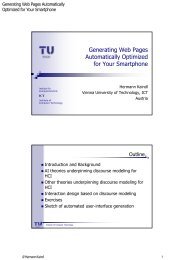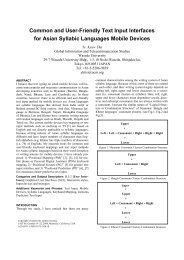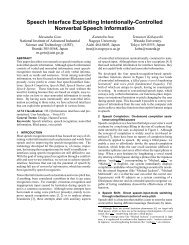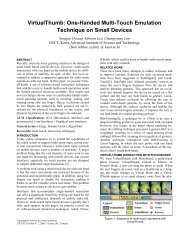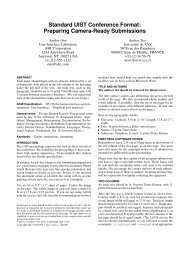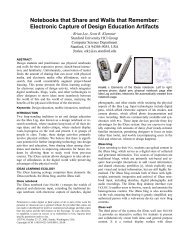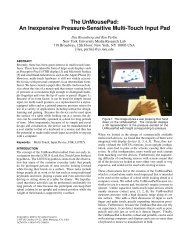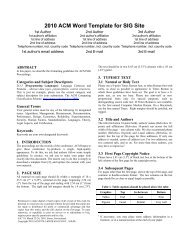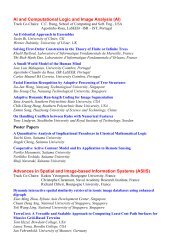API Design Matters Stonebraker and Seltzer - RabbitMQ
API Design Matters Stonebraker and Seltzer - RabbitMQ
API Design Matters Stonebraker and Seltzer - RabbitMQ
You also want an ePaper? Increase the reach of your titles
YUMPU automatically turns print PDFs into web optimized ePapers that Google loves.
Toward a<br />
Commodity<br />
Enterprise<br />
Middleware<br />
types cannot be transported in the headers; what would a<br />
Cobol program do with a Smalltalk object?<br />
Finally, AMQP draws heavily on the heritage of IETF<br />
open st<strong>and</strong>ards. It tries not to reinvent existing concepts.<br />
Early versions of the AMQP wire protocol were influenced<br />
by SMTP, 3 MIME, 4 HTTP-NG, 5 NFSv4, 6 SCTP, 7 BEEP, 8 <strong>and</strong><br />
the writings of Marshal Rose, 9 an IETF veteran.<br />
MAin FeAtUreS<br />
AMQP is split into two main areas: transport model <strong>and</strong><br />
queuing model. AMQP is unusual in that it thoroughly<br />
specifies the semantics of the services it provides within<br />
the queuing model; since applications have a very inti-<br />
mate relationship with their middleware, this needs to<br />
be well defined or interoperability cannot be achieved.<br />
In this respect, AMQP semantics are more tightly defined<br />
than JMS semantics.<br />
As stated, AMQP’s transport is a binary protocol using<br />
network byte ordering. We wanted to make it easy to<br />
embed AMQP inside the ASICs (application-specific inte-<br />
grated circuits) of network elements, by design. With free<br />
tools such as Wireshark, it is not necessary to use XML<br />
for technical infrastructure layers that only specialists will<br />
see. XML has been used in the likes of BEEP <strong>and</strong> XMPP: in<br />
the case of BEEP it complicates the protocol; in the case of<br />
XMPP it is limited to being carried on a stream-oriented<br />
transport. AMQP aims to be high performance <strong>and</strong> flex-<br />
ible, to be hardware friendly rather than human friendly.<br />
The protocol specification itself, however, is written in<br />
XML so implementers can code-generate large portions of<br />
their implementations; this makes it easier for vendors to<br />
support the technology.<br />
The transport model itself can reuse different underly-<br />
ing transports. The first is TCP/IP, but by adopting SCTP,<br />
we can obtain better parallelism for messages (SCTP<br />
removes the byte-stream head-of-line blocking problem<br />
imposed by TCP). There are also planned mappings to<br />
UDP to support AMQP over multicast, <strong>and</strong> bindings to<br />
InfiniB<strong>and</strong> are planned. InfiniB<strong>and</strong>’s performance is gen-<br />
erating a lot of interest at banks, <strong>and</strong> AMQP would make<br />
it very accessible to developers.<br />
TCP/IP, however, is expected to be the default choice<br />
for most end users for best interoperability. With these<br />
options emerging, it is important for AMQP to establish<br />
a useful functional default set of capabilities that all<br />
implementations must adhere to or suffer the lowest-<br />
common-denominator problem that plagued protocols<br />
such as early versions of NFS (many servers did not imple-<br />
ment file locking). Hopefully, a compliance testing kit will<br />
address this issue.<br />
MeSSAgeS<br />
Messages in AMQP are self-contained <strong>and</strong> long-lived, <strong>and</strong><br />
their content is immutable <strong>and</strong> opaque. The content of<br />
messages is essentially unlimited in size; 4GB messages<br />
are supported just as easily as 4KB messages. Messages<br />
have headers that AMQP can read <strong>and</strong> use to help in<br />
routing.<br />
You can liken this to a postal service: a message is the<br />
envelope, the headers are information written on the<br />
envelope <strong>and</strong> visible to the mail carrier, who may add<br />
various postmarks to the envelope to help deliver the<br />
message. The valuable content is within the envelope,<br />
hidden from <strong>and</strong> not modified by the carrier. The analogy<br />
holds quite well, except that it is possible for AMQP<br />
to make unlimited copies of the messages to deliver if<br />
required.<br />
QUeUeS<br />
Queues are the core concept in AMQP. Every message<br />
always ends up in a queue, even if it is an in-memory private<br />
queue feeding a client directly. To extend the postal<br />
analogy, queues are mailboxes at the final destination or<br />
intermediate holding areas in the sorting office.<br />
Queues can store messages in memory or on disk.<br />
They can search <strong>and</strong> reorder messages, <strong>and</strong> they may participate<br />
in transactions. The administrator can configure<br />
the service levels they expect from the queues with regard<br />
to latency, durability, availability, etc. These are all aspects<br />
of implementation <strong>and</strong> not defined by AMQP. This is<br />
one way commercial implementations can differentiate<br />
themselves while remaining AMQP-compliant <strong>and</strong><br />
interoperable.<br />
exChAngeS<br />
Exchanges are the delivery service for messages. In the<br />
postal analogy, exchanges provide sorting <strong>and</strong> delivery<br />
services. In the AMQP model, selecting a different carrier<br />
is how different ways of delivering the message are selected.<br />
The exchange used by a publish operation determines if<br />
the delivery will be direct or publish-<strong>and</strong>-subscribe, for<br />
52 May/June 2007 ACM QUEUE rants: feedback@acmqueue.com



